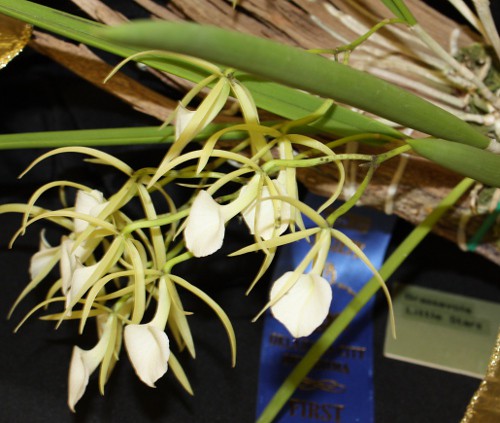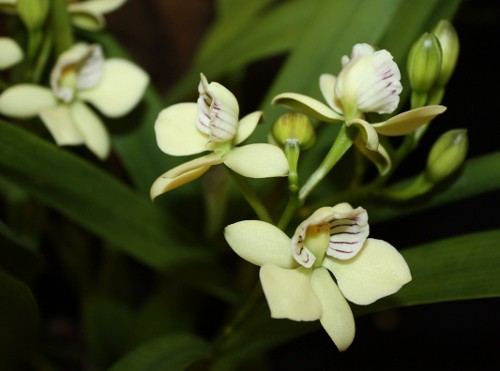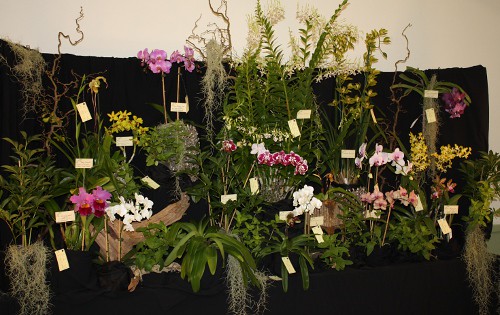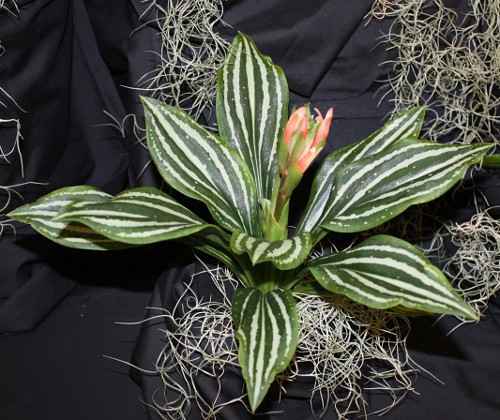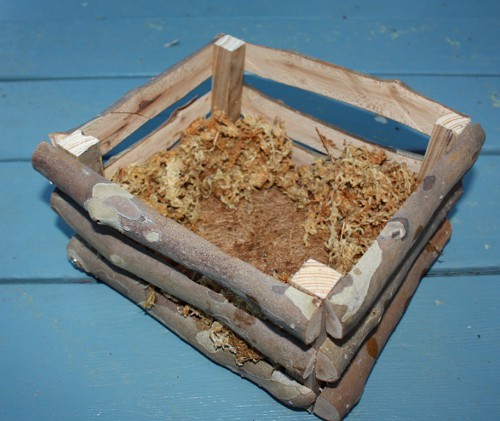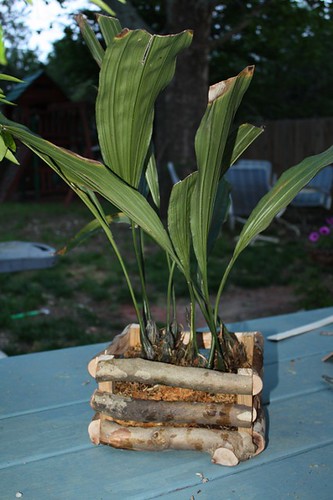This is part 3 of the 5 part series known as "Orchid Show in Wichita." If you missed the first or second post, check them out
here and
here.
First, you might be wondering what
Dendrobiums and
Encyclias have to do with one another.* The truth is just that these are two of my favorite orchid genera. There were lots of plants from these two genera at the show and I took lots of photos of them. So they grouped themselves well for a blog post. Now you know.
 |
| Me standing beside the really tall Dendrobium |
Sarah Pratt is the owner of Timbucktoo Orchids and has come to speak to our Oklahoma Orchid Society in the past year. She had a large, walk-through exhibit that featured four different very tall
Dendrobiums from section Spatulata, which means they have the tall "antlers" or "antennae." I know that I'm not a very tall guy, but still! Those plants (above) are sitting on the ground and easily two or three feet taller than I am. The sheer size of the plants can be overwhelming such that you miss how cool the individual blooms are. But I took the time to stop and
smell the rosesphotograph the flowers (below), for your enjoyment.
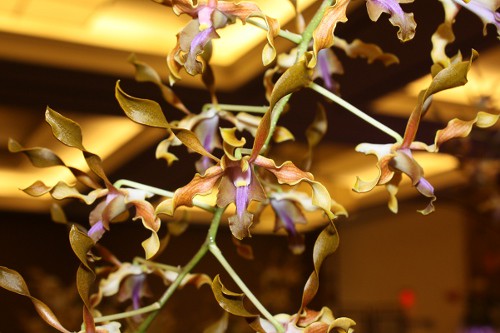 |
| Dendrobium Exotic's Spiral |
I didn't see the labels on these two orchids (below and above). The one above could possibly be Dendrobium aries. It might also be a hybrid with or without D. aries as a parent. The one below is almost definitely the species Dendrobium discolor. [Update: I contacted the owner of these plants and got both of the names. The plant above is
Dendrobium Exotic's Spiral, which is
D. Palolo Rainbow x D. strebloceras. The one below is what I was thinking, the species
Dendrobium discolor.]
 |
| Dendrobium discolor |
I recently bought a
Dendrobium kingianum. My plant is a little clump of green. This one (below) that was for sale at the Andy's Orchids table has very dark leaves of a purple/red shade. It is a really nice little plant.
 |
| Dendronium kingianum for sale at Andy's Orchids booth |
I purchased a really nice miniature
Dendrobium Micro Chip,
also known as Dendrobium Aussie Chip, because apparently there was something invalid about the name "Micro Chip." [Correction: The hybrid
Dendrobium Aussie Chip is a cross between
Den. aberrans and
Den. atroviolaceum.]
Micro Chip is a primary hybrid of
Den. aberrans x Den. normanbyense. It is covered in little white flowers that are peppered with black specks.
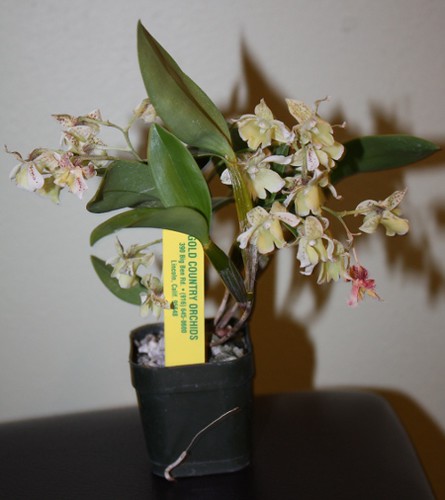 |
| Dendrobium Micro Chip |
 |
| Dendrobium Micro Chip - Birdseye view so you can see the peppering |
There are several species of
Dendrobium that are similar to my
Dendrobium anceps that
bloomed recently. One of these has dark pink blooms that are much more attractive than my little green blooms. That species (
Dendrobium rosellum) also has more coloration in the leaves themselves. There was a nice specimen (shown above) in the gigantic display at the show.
 |
| Dendrobium rosellum |
When I walk into an orchid show I am in shock for a couple of minutes. I hope that as long as I live, and as many orchid shows that I attend, I never get to the point where I don't have that experience when I first walk into one of these shows. When we got to this show, I paused momentarily and tried to get my bearings, before diving right in to look as closely as I could at the vendor tables, trying to not miss anything important. On the first table we looked at there was a large and flowering
Encyclia that smelled wonderful. It was priced so reasonably we immediately agreed that it would be going home with us. But seeing as it was the first table of plants, we were patient and decided to just keep an eye on it while we scoped out the other vendors. We ended up going back to buy it not long after, before even finishing looking at the other vendors.
 |
| Christie with Encyclia Gay Rabbit |
 |
| Encyclia Gay Rabbit closeup (Do you see the rabbit ears?) |
Christie carried this orchid around with us for most of the show. It was a bit heavy since it was a large plant, potted in a clay pot, so I joked that she was my orchid pack mule. She was a pretty happy pack mule though, because we had this awesome aroma following us around as we looked at the plants. I would relieve her for a little bit and carry the plant while pointing at plants that I wanted her to photograph for me. The plant is
Encyclia Gay Rabbit, which is a 2nd generation hybrid, including
E. cordigera and
E. alata.
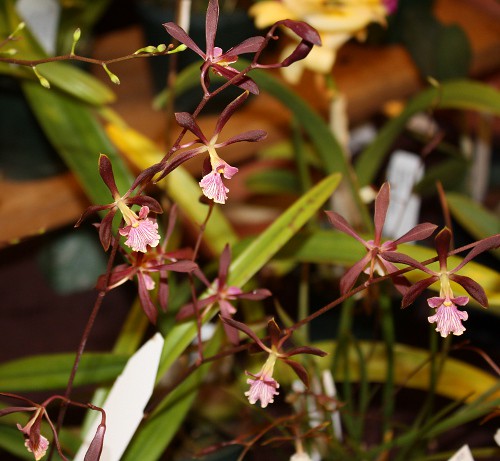 |
| Encyclia primary hybrid, with Enc. bractescens as one parent. |
I was tempted to purchase one of these hybrids with
bractescens parentage, but I got another one from Michel (below). It is
Encyclia profusa x E. fowlei. The species
E. profusa has been on my want list and I also really like
E. fowlei. It should be neat to see what this plant looks like when it blooms, and I shouldn't have to wait too long since it is in bud.
E. profusa has dainty, creamy white flowers with a little bit of pink on the lip.
E. fowlei has a creamy yellow flower with some brown streaks. The petals of
fowlei flare out a little, so there will probably be some variation in the form of the flowers. The color could be anything from white to brown, possibly with some pink on the column or lip.
 |
| My Encyclia profusa x fowlei in bud |
Michel Orchids had a lot of primary hybrids of
Encyclias and other interesting plants. The plant pictured above was one of these. I can't remember what the other parent was for this particular hybrid, but the
Enc. bractescens is pretty apparent with these tiny flowers and the thin leaves.
 |
| Encyclia (possibly cordigera v. rosea) |
The plant above is probably
Encyclia cordigera v.
rosea, but I didn't take a picture of the label so I can't be sure. Either way, it's a nice orchid with fragrant flowers.
 |
| Encyclia Hereford Jewel (Enc. cordigera x Enc. bractescens) |
The plant above is another primary hybrid that was on display and had received several awards. It is obviously being grown well considering the number of flowers.
* If you're curious about how closely related
the
Dendrobium and
Encyclia genera are, they are both within the same subfamily, Epidendroideae. That doesn't say too much though, considering there are only five subfamilies in the Orchid family, which is hugely diverse. Also, the Epidendroideae subfamily is the largest with 576 genera and more than 15,000 species.





